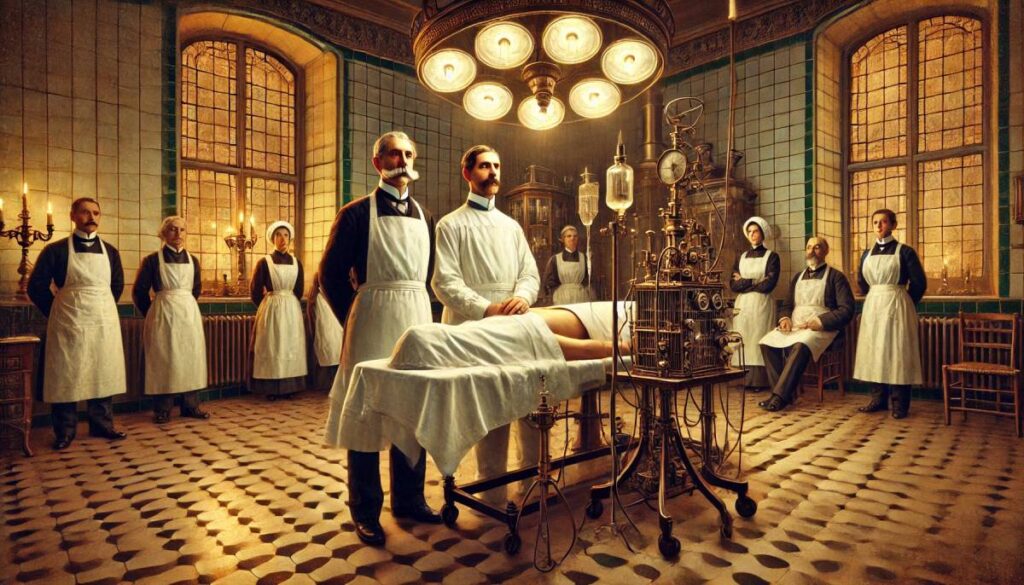Anesthesia has transformed surgery from a painful and traumatic experience into a more manageable and humane procedure. The development of anesthesia involved contributions from numerous key figures across different cultures and backgrounds, some of whom are often overlooked in mainstream accounts of the history of the field.
William T.G. Morton, a Boston dentist, is often credited with the first successful demonstration of ether anesthesia in 1846. Morton’s demonstration at Massachusetts General Hospital was groundbreaking, as it allowed patients to undergo surgery without feeling pain. This marked a pivotal moment in medical history, as it provided a safer and more effective alternative to the previously common practice of using alcohol or opiates to dull pain. Morton’s achievement helped to popularize anesthesia generally, but his role in its development has been clouded by controversy surrounding his patenting of the procedure and disputes with other medical professionals 1–3.
Crawford Long, an American surgeon, is often credited with being the first to use ether as an anesthetic in 1842, four years before Morton’s famous demonstration. However, Long did not publish his findings until years later, leading to Morton receiving more widespread recognition. Long’s discovery of ether’s anesthetic properties was a key milestone in the history of anesthesia, and his work deserves acknowledgment for its early role in advancing surgical pain relief 4–6.
While William Morton is often hailed as the “father of modern anesthesia,” John Snow, a British physician, is another key figure whose contributions were essential to the development of anesthesia. Snow, widely recognized as the father of modern epidemiology, was the first to use chloroform as an anesthetic in 1847. He famously administered chloroform to Queen Victoria during the birth of her eighth child, which helped to popularize its use in obstetrics 7–9.
Many key figures in the history of anesthesia are often underrepresented in traditional narratives. One such figure is James Durham, a physician who was active in the 18th century. Durham, a freed slave, is known for his work in medicine and is believed to have been one of the first individuals in America to use a form of ether anesthesia for surgical procedures 10,11.
Helen Octavia Dickens, a pioneering obstetrician and gynecologist, is also often overlooked. Dr. Dickens is known for her advocacy in the development of anesthetic techniques in obstetrics. She worked tirelessly to improve pain management for women in labor, including supporting the use of regional anesthesia, which was critical to reducing the risks associated with childbirth during her time. Her work remains a key contribution to the field, even if her name does not always appear in medical textbooks 12–14.
By recognizing the valuable contributions of key figures throughout the history of anesthesia, we can obtain a more inclusive understanding of how the field evolved, offering a fuller picture of its development and the many individuals who created the foundation for modern anesthesia.
References
- History of Anesthesia. Wood Library-Museum of Anesthesiology https://www.woodlibrarymuseum.org/history-of-anesthesia/.
- The surprisingly painful origins of modern anesthesia. About JSTOR https://about.jstor.org/blog/the-surprisingly-painful-origins-of-modern-anesthesia/.
- Robinson, D. H. & Toledo, A. H. Historical development of modern anesthesia. J Invest Surg 25, 141–149 (2012). DOI: 10.3109/08941939.2012.690328
- Crawford W. Long (1815-1878) Discoverer of Ether for Anesthesia. JAMA 194, 1008–1009 (1965). DOI: 10.1001/jama.1965.03090220064022
- Boland, F. K. Crawford Long and the Discovery of Anesthesia. The Georgia Review 6, 89–99 (1952).
- Boland, F. K. The First Anesthetic: The Story of Crawford Long. (Univ. of Georgia Press, Athens, 2009).
- John Snow: the making of a hero? – The Lancet. https://www.thelancet.com/journals/lancet/article/PIIS0140673608609782/fulltext.
- Ramsay, M. A. E. John Snow, MD: anaesthetist to the Queen of England and pioneer epidemiologist. Proc (Bayl Univ Med Cent) 19, 24–28 (2006). DOI: 10.1080/08998280.2006.11928120
- Shephard, D. A. E. History of Anaesthesia: John Snow and Research. Can J Anaesth 36, 224–241 (1989). DOI: 10.1007/BF03011450
- Contributing Writer. He was New Orleans’ (and America’s) first black doctor, but few know his name. NOLA.com https://www.nola.com/300/he-was-new-orleans-and-americas-first-black-doctor-but-few-know-his-name/article_5d0116f1-f785-5477-abeb-a08ef84195cf.html (2018).
- James Durham, 18th Century African American Physician. https://muttermuseum.org/stories/posts/james-durham-18th-century-african-american-physician.
- Facts Dickens. ACS https://www.facs.org/about-acs/governance/board-of-governors/resources/facts-dickens/.
- Changing the Face of Medicine | Helen Octavia Dickens. https://cfmedicine.nlm.nih.gov/physicians/biography_82.html.
- Helen Octavia Dickens, MD | Office of the Chief Scientific Officer | Perelman School of Medicine at the University of Pennsylvania. https://www.med.upenn.edu/evdresearch/helen-o-dickens.html.



